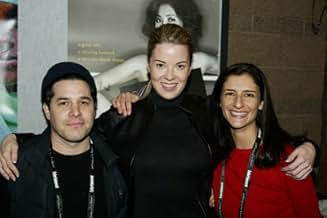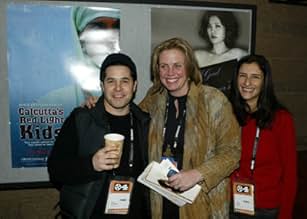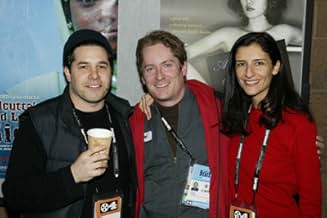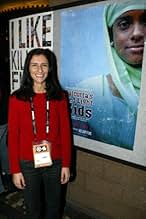CALIFICACIÓN DE IMDb
7.2/10
18 k
TU CALIFICACIÓN
Agrega una trama en tu idiomaTwo documentary filmmakers chronicle their time in Sonagchi, Calcutta and the relationships they developed with children of prostitutes who work the city's notorious red light district.Two documentary filmmakers chronicle their time in Sonagchi, Calcutta and the relationships they developed with children of prostitutes who work the city's notorious red light district.Two documentary filmmakers chronicle their time in Sonagchi, Calcutta and the relationships they developed with children of prostitutes who work the city's notorious red light district.
- Ganó 1 premio Óscar
- 21 premios ganados y 5 nominaciones en total
Zana Briski
- Self "Zana Auntie"
- (sin créditos)
Sunil Halder
- Self
- (sin créditos)
- …
- Dirección
- Guionistas
- Todo el elenco y el equipo
- Producción, taquilla y más en IMDbPro
Argumento
¿Sabías que…?
- Bandas sonorasSankarabaranam pancha nadai pallavi
Performed by Shenkar and The Epidemics
Opinión destacada
Today I saw "Born into Brothels" at day 3 of 4 of the Full Frame Documentary Film Festival. Even with another day left, I have some confidence that this will be the film I most appreciated seeing at this festival, and in fact is one of the most inspiring films I have seen in a long time. Directors and producers Zana Briski and Ross Kauffman also hosted a question and answer session after the film, and I had the privilege of meeting and talking with Zana Briski, whose intimate involvement in this film and her selfless efforts have given me tremendous admiration for what she does; as I said in the Q&A period, if we had a few more people like her, the world would be a vastly better place for all of us.
Ms. Briski is an established photographer and now first time director who began in 1997 to explore the lives of sex workers in Calcutta's red-light district, Sonagachi, where over 7000 women and (disgustingly sadly) girls are prostitutes. In order to better understand them, Zana lived for months at a time with them, and the children quickly befriended her. The children were curious to try their hands at taking pictures, and Zana helped to empower them and see the world through their eyes by teaching them photography and acquiring point-and-shoot 35mm film cameras for them, as well as helping them to critique and edit their pictures.
The resulting pictures that the children took between the years 2000 and 2003 are striking. Some of the children clearly have innate talent in composition and artistry (see, for example, shot 17 "Girl on a Roof" or 14 "Horse", at the Kids with Cameras site mentioned at the bottom of my review), and all of them have works portraying the vitality of life so much so that Zana helped get one child invited to be part of a children's jury at a World Press Photo Foundation photo exhibit in Amsterdam in 2002, and for him to actually attend.
Zana admits in the film that she is not a social worker, but wanted very much to help the boys and girls, for otherwise their future was a dismal one lacking hope beyond prostitution, drugs, pimping, and crime. She organized a photo exhibit in a Calcutta bookstore, garnering Zana's project and the individual children television and newspaper coverage. Zana has recently set up an organization, Kids with Cameras, that sells their prints to raise money for them, with 100% of the profits going to them. Twelve of these prints were the ones chosen for the 2003 "Amnesty International" calendar, and she even exhibited and auctioned the children's work at Sotheby's. She has helped to get several of the children into good boarding schools and recently helped a few to get email access and English lessons.
The film itself is technically beautiful, with a melange of colors, sounds, and activity, centered on the children but also including others. The filmmakers in no way hide the unsavory life in Sonagachi, including disturbing cursing against the children, hopelessness of being able to in any way be involved in normal society, having no governmental support, facing tremendous bureaucracy to get anything changed even with Ms. Briski's help, and the total lack of police investigation or protection as painfully brought to light when one child's mother is killed by a pimp in a "kitchen fire". In making the film, Mr. Kauffman and Ms. Briski effectively used fast camera pans, red overtints, and grainy film at times to portray an environment where participants would not want to be carefully filmed. They could have made this a sad and detailed documentary about this red light slum, but instead chose to recognize its nature but focus on the innocence of the children and hope that could be offered them.
If you have the opportunity to see this film at a festival, don't miss it. I understand that HBO/Cinemax may be distributing the film as well to afford a much wider audience. It is a heartwarming film that left me with a jumble of emotions - hopefulness and hopelessness; incredulity and shock at human nature combined with tremendous admiration at the selflessness and difference that one person can make; sadness at the overwhelming poverty, filth, and insouciance of a society that lets a community like Songagachi exist and yet tremendous happiness at the children's glee in living their lives with innocent play and their ambition to move out of the community. For the quality and uniqueness of the film, as well as the tremendous service that Zana Briski portrays, this film gets 10 stars out of 10 in my book. Don't miss this jewel of a film - and consider supporting the work that goes on.
--Dilip Barman April 3, 2004
Ms. Briski is an established photographer and now first time director who began in 1997 to explore the lives of sex workers in Calcutta's red-light district, Sonagachi, where over 7000 women and (disgustingly sadly) girls are prostitutes. In order to better understand them, Zana lived for months at a time with them, and the children quickly befriended her. The children were curious to try their hands at taking pictures, and Zana helped to empower them and see the world through their eyes by teaching them photography and acquiring point-and-shoot 35mm film cameras for them, as well as helping them to critique and edit their pictures.
The resulting pictures that the children took between the years 2000 and 2003 are striking. Some of the children clearly have innate talent in composition and artistry (see, for example, shot 17 "Girl on a Roof" or 14 "Horse", at the Kids with Cameras site mentioned at the bottom of my review), and all of them have works portraying the vitality of life so much so that Zana helped get one child invited to be part of a children's jury at a World Press Photo Foundation photo exhibit in Amsterdam in 2002, and for him to actually attend.
Zana admits in the film that she is not a social worker, but wanted very much to help the boys and girls, for otherwise their future was a dismal one lacking hope beyond prostitution, drugs, pimping, and crime. She organized a photo exhibit in a Calcutta bookstore, garnering Zana's project and the individual children television and newspaper coverage. Zana has recently set up an organization, Kids with Cameras, that sells their prints to raise money for them, with 100% of the profits going to them. Twelve of these prints were the ones chosen for the 2003 "Amnesty International" calendar, and she even exhibited and auctioned the children's work at Sotheby's. She has helped to get several of the children into good boarding schools and recently helped a few to get email access and English lessons.
The film itself is technically beautiful, with a melange of colors, sounds, and activity, centered on the children but also including others. The filmmakers in no way hide the unsavory life in Sonagachi, including disturbing cursing against the children, hopelessness of being able to in any way be involved in normal society, having no governmental support, facing tremendous bureaucracy to get anything changed even with Ms. Briski's help, and the total lack of police investigation or protection as painfully brought to light when one child's mother is killed by a pimp in a "kitchen fire". In making the film, Mr. Kauffman and Ms. Briski effectively used fast camera pans, red overtints, and grainy film at times to portray an environment where participants would not want to be carefully filmed. They could have made this a sad and detailed documentary about this red light slum, but instead chose to recognize its nature but focus on the innocence of the children and hope that could be offered them.
If you have the opportunity to see this film at a festival, don't miss it. I understand that HBO/Cinemax may be distributing the film as well to afford a much wider audience. It is a heartwarming film that left me with a jumble of emotions - hopefulness and hopelessness; incredulity and shock at human nature combined with tremendous admiration at the selflessness and difference that one person can make; sadness at the overwhelming poverty, filth, and insouciance of a society that lets a community like Songagachi exist and yet tremendous happiness at the children's glee in living their lives with innocent play and their ambition to move out of the community. For the quality and uniqueness of the film, as well as the tremendous service that Zana Briski portrays, this film gets 10 stars out of 10 in my book. Don't miss this jewel of a film - and consider supporting the work that goes on.
--Dilip Barman April 3, 2004
- Dilip
- 13 abr 2004
- Enlace permanente
Selecciones populares
Inicia sesión para calificar y agrega a la lista de videos para obtener recomendaciones personalizadas
Detalles
- Fecha de lanzamiento
- País de origen
- Sitio oficial
- Idiomas
- También se conoce como
- Born Into Brothels: Calcutta's Red Light Kids
- Locaciones de filmación
- Productoras
- Ver más créditos de la compañía en IMDbPro
Taquilla
- Total en EE. UU. y Canadá
- USD 3,515,061
- Fin de semana de estreno en EE. UU. y Canadá
- USD 14,605
- 12 dic 2004
- Total a nivel mundial
- USD 3,529,201
- Tiempo de ejecución1 hora 25 minutos
- Color
- Mezcla de sonido
- Relación de aspecto
- 1.37 : 1(original negative)
- 1.85 : 1
Contribuir a esta página
Sugiere una edición o agrega el contenido que falta

Principales brechas de datos
What is the Spanish language plot outline for Nacidos en los burdeles (2004)?
Responda




















